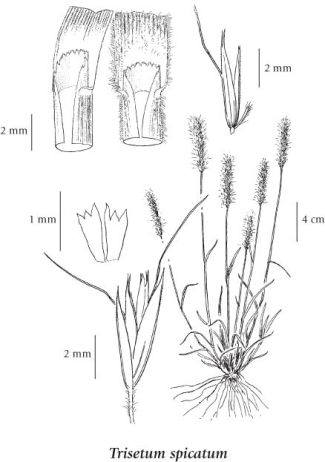Trisetum spicatum (L.) K. Richt.
spike trisetum
Poaceae (Grass family)
Introduction to Vascular Plants
spike trisetum
Poaceae (Grass family)
Introduction to Vascular Plants
Species Information
General:
Perennial, tufted grass from fibrous roots; stems rough or short-hairy, 10-50 (70) cm tall.
Leaves:
Sheaths open, the basal sheaths short-hairy; blades folded to flat, minutely rough, 1.5-4 (5) mm wide; ligules usually hairy externally, finely jagged and more or less fringed with fine hairs, 0.5-2 (averaging 1) mm long.
Flowers:
Inflorescence a dense, spikelike, usually continuous but often interrupted, purplish, tawny or silvery panicle, 2-15 cm long; spikelets 2- to 3-flowered, nearly unstalked; glumes membranous, the lower ones averaging about (3) 4 (4.5) mm long, the upper ones mostly rough on the keels, 1/5-1/4 longer and about 1/2 again as wide, usually surpassing the lower florets and nearly equal to the upper florets; lemmas usually minutely rough, 4-5 mm long, bidentate, awned, the awns strongly abruptly bent, broadly spreading, arising up to 1.5 mm below the tips of the lemmas, 5-6 mm long; lodicules nearly entire to sharply lobed, about 0.7-1 mm long; anthers up to 1.5 mm long.
Notes:
This is a highly variable species which cannot realistically be separated into infraspecific taxa. Even Hulten (1959), who recognized 14 subspecies in the T. spicatum complex, stated that "...the differentiation between the different taxa becomes somewhat arbitrary..." for our western cordilleran material.
Illustration

If more than one illustration is available for a species (e.g., separate illustrations were provided for two subspecies) then links to the separate images will be provided below. Note that individual subspecies or varietal illustrations are not always available.
Illustration Source: The Illustrated Flora of British Columbia
USDA Species Characteristics
Flower Colour:
Yellow
Blooming Period:
Indeterminate
Fruit/Seed characteristics:
Colour: Brown
Present from Summer to Fall
Source: The USDA
Ecology
Ecological Framework for Trisetum spicatum
The table below shows the species-specific information calculated from
original data (BEC database) provided by the BC Ministry of Forests and Range.
(Updated August, 2013)
The table below shows the species-specific information calculated from
original data (BEC database) provided by the BC Ministry of Forests and Range.
(Updated August, 2013)
| Site Information |
Value / Class |
||
|
Avg |
Min |
Max |
|
| Elevation
(metres) |
1787 | 7 | 3000 |
| Slope
Gradient (%) |
26 | 0 | 230 |
|
Aspect (degrees) |
182 | 0 | 360 |
| Soil
Moisture Regime (SMR) [0 - very xeric; 4 - mesic; 8 - hydric] |
2 | 0 | 8 |
| Modal
Nutrient Regime
Class |
C | ||
| #
of field plots species was recorded in: |
1802 | ||
| Modal
BEC Zone Class |
ESSF | ||
|
All BEC Zones (# of stations/zone) species was recorded in |
AT(164), BAFA(288), BWBS(24), CDF(2), cma(11), CWH(3), ESSF(736), ICH(21), IDF(53), IMA(80), MH(23), MS(136), SBPS(70), SBS(53), SWB(50) | ||
|
Source:
Klinkenberg 2013
|
|||
Habitat and Range
Moist to dry, often rocky sites in all vegetation zones; common throughout BC although less frequent along the coast; circumpolar, N to AK, YT and NT, E to NF and S to ME, MA, PA, VA, TN, MN, SD, NM, AZ, CA and MX; Eurasia, S America.Status Information
Synonyms
Synonyms and Alternate Names:
Aira spicata L.
Trisetum molle Kunth
Trisetum montanum Vasey
Trisetum montanum var. shearii Louis-Marie
Trisetum spicatum subsp. alaskanum (Nash) HultΘn
Trisetum spicatum subsp. congdonii (Scribn. & Merr.) HultΘn
Trisetum spicatum subsp. majus (Rydb.) HultΘn
Trisetum spicatum subsp. molle (Kunth) HultΘn
Trisetum spicatum subsp. montanum (Vasey) W. Weber
Trisetum spicatum subsp. pilosiglume (Fernald) HultΘn
Trisetum spicatum var. alaskanum (Nash) Malte ex Louis-Marie
Trisetum spicatum var. congdonii (Scribn. & Merr.) Hitchc.
Trisetum spicatum var. maidenii (Gandog.) Fernald
Trisetum spicatum var. majus (Rydb.) Farw.
Trisetum spicatum var. molle (Kunth) Beal
Trisetum spicatum var. pilosiglume Fernald
Trisetum spicatum var. spicatiforme HultΘn
Trisetum spicatum var. villosissimum (Lange) Louis-Marie
Trisetum subspicatum (L.) Beauv.
Trisetum triflorum (Bigelow) A. L÷ve & D. L÷ve
Trisetum triflorum subsp. molle (Kunth) A. L÷ve & D. L÷ve
Trisetum villosissimum (Lange) Louis-Marie